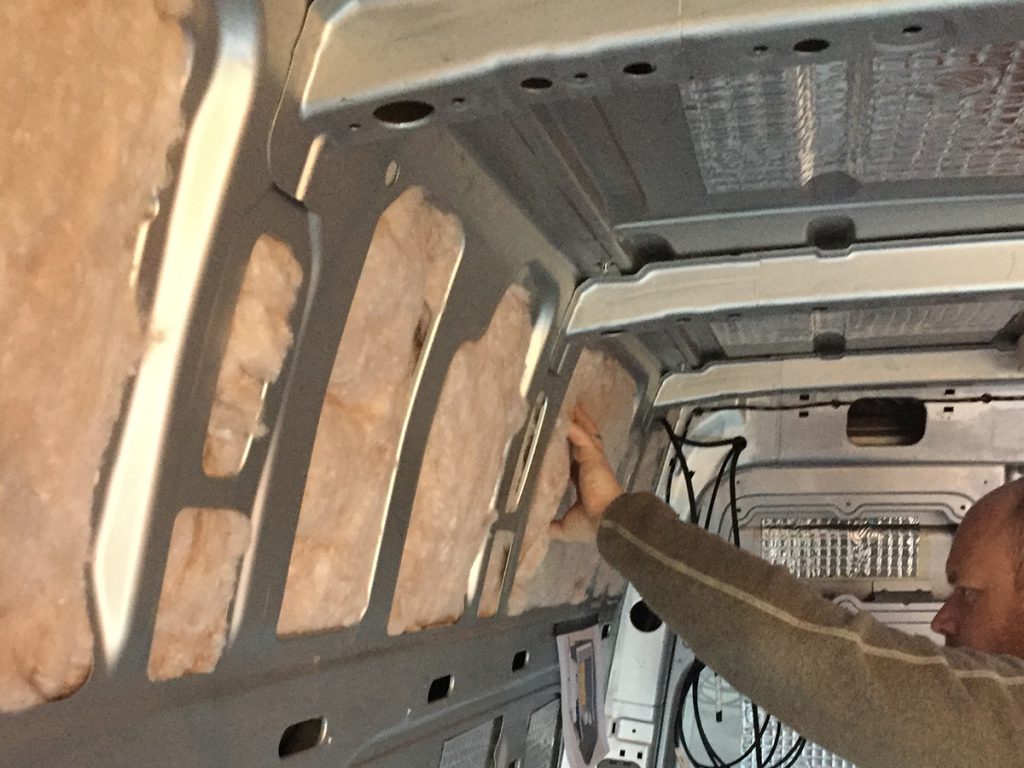Insulating Your Camper Van

The first major step the van building process is insulating your camper van. As with everything in your van build, it’s important that you understand how something works in order to most effectively do it, so let’s talk about how insulation works. Insulation has everything to do with heat transfer, of which there are three types:
Radiation: Heat transferred through air (i.e. sunlight). Radiant heat is primarily tied to van windows.
Conduction: Heat transferred through solids (i.e. touching something cold and feel your hand get cold). In other words, if it’s cold outside, the metal body of your van will conduct the heat inside to the outside, cooling the van’s internal temperature. Vice versa for hot temperatures. Remember, hot always moves to cold. When you touch something cold, it feels like the cold is creeping into your hand, but actually, it’s the cold object drawing the heat away.
Convection: Heat transferred through liquid or gas (i.e. warm air rising). This is why it’s important to insulate your ceiling more completely than any other area of your van if you’ll be spending any time in the cold. If you plan to stick purely to hot climates, then insulate it much more lightly. However, keep in mind that a vent van does the job of sucking out risen hot air, so you can always remedy having too thick of ceiling insulation, but you’ll be hard pressed to make it more insulated late on should you need.
What’s all this got to do with van insulation? Well, in simple terms, van insulation slows and disrupts these types of heat transfer, keeping your van warmer in the cold, or cooler in the heat.
Insulation Options
Rigid foam board:
These are generally going to be the best in terms of balancing budget with non-toxicity. Foam boards are not quite a cheap insulation like fiberglass, but it’s still an affordable van insulation when compared to more sustainable, non-toxic insulation, as we’ll talk about below.
Expanded polystyrene (EPS): This is a lot like Styrofoam, though many forms of it resemble polyiso foam in that they have a foil faced side for additional radiant heat barrier capability. While it has the lowest durability and R-value of the foam boards, it’s super cheap, and still pretty insulating, so it’s a solid option for low-budget van builds. Many people complain about the ease with which moisture can penetrate and break down the foam over time, but this is easily remedied if you’re careful to purchase the kinds with polymeric skins on both sides that shield the actual foam from moisture.
Extruded polystyrene (XPS): These are the big pink and blue foams board you’ll see in the hardwear store, a common form of insulation that is also resistant to moisture and runs middle of the road price wise. Unfortunately, it is not very environmentally friendly due to the HFC greenhouse gases released in the production.
Polyisocyanurate (polyiso): Another good “green” option that’s non-toxic, non-gassing, and has a high-insulating factor. Cost wise, it’s definitely affordable, but a little more expensive than the other rigid foam boards, but has the added benefit of having a foil faced side for use as a radiant heat and moisture barrier.
R-Tech InsulFoam: This combines elements from several of the other foam types and is actually what we used for our van. The core is EPS foam, but each side is covered in polymeric skins, one of them being a thermo-reflective radiant heat barrier. This foam is designed to be resistant to both insects and moisture. Unlike traditional EPS, is has a greater compressive strength (still not quite as much as XPS) and dimensional stability. It sort of combines all the best elements of the other foams and is Energy Star certified.
***We used the 1” thick boards, with an R-value of R7.6, if used with proper air space to allow for the reflective film to be effective. This is a pretty high value and we’re happy with it. Of course, a thicker board would yield an even higher R-Value, but then the air space between the insulation and the wall panels would be less and it would take up more interior space, which is why we recommend 1” thickness for any foam board insulation.
Fiberglass batting:
Before we go any further, let me just say you don’t want to use this. Plenty of van builders so, but we definitely don’t recommend it. But let’s backtrack a bit. Traditional fiberglass insulation is the most common type of insulation, the default used in houses and traditional building. In a confined space like a van, however, it’s not a good idea because fiberglass insulation is known as particulate insulation. That means it is comprised of particles that slough off that you’ll breathe in over time. Non-particulate van insulation is far safer for the lungs.
Plus, it’s prone to mold and mildew with the natural condensation that will form in your van unless you completely seal it with a vapor barrier liner (VBL). That’s still no guarantee. So why do people use it? Well it’s by far the easiest and most cost effective option with a high R-value because of the batting structure. Vans are prone to infuriatingly unusual shapes and lots of small nooks and crannies, such the ribs and the holes around the floor. Fiberglass batting is so easy to stuff in these holes.
Non-particulate/non-toxic batting:
Mineral/Rock Wool: This hard-to-find form of insulation is basically recycled stone spun into fine fibers. However, it’s REALLY expensive relative to its R-Value and doesn’t allow for condensation to vent, which will eventually breed mold. The last thing you’ll want to do is rip down the walls and cabinets to solve any toxic mold problems.
Sheep’s Wool: An increasingly popular form of sustainable van insulation, this 100% natural batting is non-toxic, non-particulate and far more moisture resistant than other battings. Think of a wool shirt; wool is valued because of its ability to keep insulating even when wet. The same goes for your van, and it actually manages overall van moisture because it wicks it away from whatever paneling you put over it and is resistant to mold. However, it can be hard to find and has a relatively low R-Value, meaning you would need to sacrifice a lot of space to use enough of it for it to be effective.
Denim: Also an organic-based, sustainable insulation option for your camper van. This is the particleboard of the insulation world, made of scraps of recycled denim. It insulates comparably to fiberglass but is more expensive. However, as it is cotton, it soaks up and holds on to moisture, so again not ideal for a van.
3M Thinsulate:
If you’re a gear junkie like I am, you may have heard the term Thinsulate; it’s used as a synthetic insulation of many high end outdoor puffy jackets. It’s also acts as a sound deadening insulation for vans, ultra breathable (hence its use in outdoor activities clothing) and easy to install. This is probably the single most expensive option for the little R-value it provides. However, it’s a good option for filling the awkward nooks and crannies that foam can’t reach.
Closed-cell Polyurethane Spray Foam:
This is basically expanding liquid that sprays out, foams up, and solidifies into a hard mass. You can buy entire kits to do your whole van, a messy process that would cost you upwards of $500 and wouldn’t allow you to change anything about the insulation, or you can do what most van builders do: use it to fill in the gaps and cracks. In fact, the spray you want is literally called Great Stuff Gaps and Cracks. Use this to seal around your other insulation and to fill in the awkward pockets of the van, like the ribs. If applied properly, it also seals out moisture so condensation won’t build up between your metal walls and your insulation.
Reflectix:
Basically reflective bubble-wrap that works as a great radiant heat barrier. However, do not make the mistake of using Reflectix as your sole form of insulation, as many van builders have done. It only has an R-value of about R1. Instead, this is better used for window coverings and in other small gaps of your van. Keep in mind: radiant heat barriers only work if there is an air gap next to it. That’s why it works fine as a window covering or in the ribs of your van, where a natural air cavity will exist in front of it. It will not work if you cover your walls with it then panel over it.
Mind the Moisture: Are VBLs Necessary?
The biggest problem you could run into down the road with your insulation is condensation and subsequent mold and mildew. Condensation is a natural thing in your van, but it’s important to protect the metal body of your van from it. Water is not its friend; rust is really the biggest killer of vans, especially older, non-coated ones. Some believe that in order to protect the inner metal walls of your van from moisture build-up, you need to install a vapor barrier liner (VBL) over top the insulation so moisture from the living space can never get to the walls.
Others think it unnecessary as long as your van is properly ventilated with a vent fan. Plus, one small flaw in a VBL can still allow moisture to get in and then trap it behind. Personally, I’m not a fan of the VBL and think that condensation can be mitigated and pulled from your van with a good vent fan (which you definitely need anyway). Any that does build up on the walls will drip down and run out floor vents that most modern cargo vans are made with.



Comments
Post a Comment